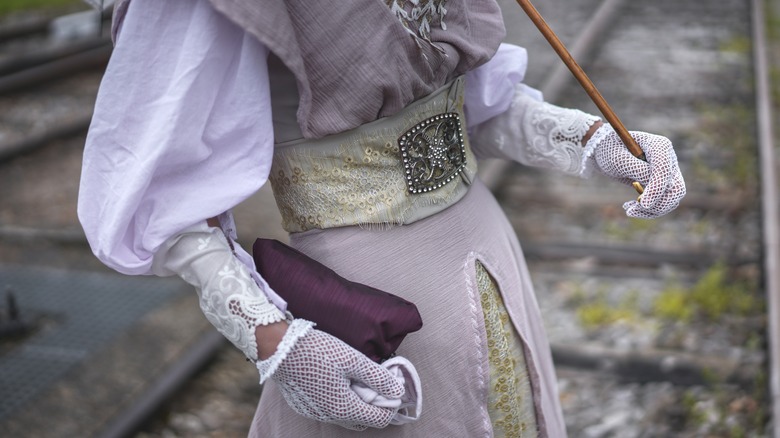A Pair Of Amateur Sleuths Believe They've Solved The Century-Old Murder That Inspired 'Twin Peaks'
On Monday, July 6, 1908, two women met while waiting for a train at the Troy Union Station in Troy, New York. In a later interview with authorities, Mary Robinson said a 20-year-old woman named Hazel Drew asked her where she was traveling. When Robinson asked Drew the same question, HazelDrew.com reports, she simply replied, "Oh, down the river. Perhaps as far as New York." Robinson said Drew had a suitcase with her and appeared to be waiting for someone. The women's conversation was cut short when the trail arrived at the station. However, Robinson said she saw Drew purchase a ticket and walk toward the platform at around 11:30 a.m.
As reported by HazelDrew.com, the only train leaving the Troy Union Station at that time was a local train traveling between Troy and Albany. Although it was never proven, it is assumed that Drew took a train to Albany and returned to Troy later that same afternoon.
Her murder went unsolved for more than 100 years
Hazel Drew was spotted once again at the Troy Union Station at approximately 1:15 p.m. that same afternoon (via HazelDrew.com). At the time, she did not have the suitcase she was seen carrying earlier in the day. The following afternoon, a man named Peter Cipperly claims he saw Drew, who was accompanied by a young man, on a trolley on its way to Averill Park.
Later that evening, HazelDrew.com reports two witnesses saw Drew walking along a remote road in a heavily wooded area on Taborton Mountain. The temperature was over 90 degrees F that day, and Drew was wearing clothing more appropriate for socializing than a walk in the woods.
Four days later, Drew was found dead in Teal's Pond. A medical examiner later determined the cause of death was blunt force trauma to the head, which crushed her skull. New York Post reports her manner of death was determined to be suicide, but authorities suspected foul play. In the course of the investigation, law enforcement officials uncovered a myriad of unusual events leading up to Drew's death and a number of possible suspects. However, the murder went unsolved for more than 100 years.
Hazel Drew's family found love letters amid her possessions
At the age of 14, Hazel Drew left home to work as a governess for an influential and wealthy family. By all accounts, Drew was friendly and hard-working. The True Crime Edition reports she was also known as an attractive girl with fair hair and blue eyes. By the time she was in her late teens, Drew was specifically popular with the young men in the area, who were charmed by her appearance and personality. However, it is unclear whether she was dating anyone specific at the time of her death.
As reported by New York Post, Drew's family went through her personal belongings in an attempt to determine who may have had motive to kill her. They were stunned to find multiple letters from men declaring their love and devotion to their daughter. A reporter working for New York World claimed to have found another box among Drew's possessions that was full of bills and receipts. The reporter said one of the receipts was for "French female pills," which were prescribed to regulate menstrual cycles, but could also be used to terminate a pregnancy.
Her friends said she was living beyond her means
In the months prior to her death, Hazel Drew's friends said she was living beyond her means. As reported by HazelDrew.com, Drew's friend Carrie Weaver said Drew purchased expensive clothing, took several extravagant trips, and often dined at exclusive restaurants — despite her meager income as a governess. However, Weaver said she never saw any indication that Drew had a boyfriend who was funding her lifestyle. In the months prior to her death, Drew had been working as a governess for the city mayor's family. However, just days before she was killed, Drew unexpectedly resigned.
Although the murder went unsolved for more than 100 years, the brutal nature of Drew's death, along with her unusual behavior and revelations about her so-called "secret life," became well-known throughout the region and sparked a number of cautionary tales and legends. According to The True Crime Edition, those legends eventually inspired Mike Frost and David Lynch to create a television series titled "Twin Peaks," loosely based on Drew's murder.
Her murder inspired the television series 'Twin Peaks'
During an interview with The Washington Post, Mike Frost said, "It was the notion of this girl's body being found on the edge of the water, the mystery remaining unsolved, the multiple suspects, and the kind of cross-cultural and different social classes of people she interacted with. It really struck my fancy."
In the series "Twin Peaks," Laura Palmer's murder was solved within 15 episodes. Although Hazel Drew's murder remains officially unsolved, authors David Bushman and Mark Givens believe they know who killed her and why the murder was never officially solved. As reported by the New York Post, Bushman and Givens believe Drew was killed by two prominent members of her community.
On the evening of July 7, 1908, William and Elizabeth Hoffay were riding in their carriage near Teal's Pond. According to their account, the Hoffays passed another carriage, which was occupied by two men. The Hoffays said the other carriage seemed out of place, as it was clearly custom designed and more luxurious than carriages usually seen in the rural area.
New York Post reports the Hoffays also reported seeing a third person standing on the shore of Teal's Pond. Although they could not identify the person, authorities found some of Drew's personal belongings at the same spot where the Hoffays saw the person standing.
Hazel Drew's murder was never officially solved
The Hoffays reported the incident to police, who identified the driver of the other carriage as embalmer and local politician Fred W. Schatzle. As reported by the New York Post, the passenger was identified as William Cushing, who was also a prominent politician. Both men admitted being in the area near Teal's Pond on the evening in question and admitted having known Hazel Drew. However, neither man was charged with Drew's murder.
In their book, "Murder at Teal's Pond," David Bushman and Mark Givens suggest local law enforcement officials refused to arrest Cushing and Schatzle, as they were trying to protect the prominent men. Bushman and Givens are unsure what may have motivated the murder. However, they suggest Drew's employment in the homes of some very prominent and influential men may have somehow put her in harm's way.
According to the New York Post, Bushman and Givens said, "Any of these men could have been motivated to have Hazel killed. None were seriously investigated at the time. All had ties to the Republican Party and it seems easier to accept that ... detectives would have been motivated to cover up the activity of Cushing and Schatzle if they had been acting for someone with influence ... especially someone in the party."
Authorities have not commented on Bushman and Givens' theory and have not announced any breakthroughs in their investigation into Drew's murder.





